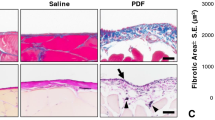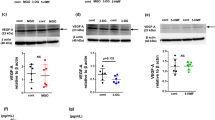Abstract
The purpose of this study was to investigate the possibility that healing processes following repeated injury by nonphysiological dialysate play a significant role in the pathogenesis of peritoneal ultrastructural alteration, mediated by the production of growth factors and extracellular matrix proteins (ECM). To test a possible mechanism for peritoneal membrane alteration, we investigated whether chemically injured peritoneal mesothelial cells and fibroblasts upregulate their production of growth factors and ECM as a consequence of the healing process. Using 1 N NaOH, circular wounds of uniform surface area were made in monolayers of subconfluent rat peritoneal mesothelial cells (RPMC) and peritoneal fibroblasts (RPFB). At 0, 24, and 72 h after wounding, changes in mRNA expression of transforming growth factor-beta 1 (TGF-Β1), b-FGF, HGF, VEGF, and FN were semiquantified by reverse transcription-polymerase chain reaction. Nonwounded monolayers of RPMC and RPFB were used as controls with mRNA expression being determined at the same times. For RPMC, TGF-Β1, HGF, b-FGF, and FN mRNA gradually increased up to 72 h postwounding to 1.5-fold, 1.6-fold, 1.3-fold, and 2.1-fold of the control levels, respectively. A significant increase was only observed for TGF-Β1, while VEGF showed the least change with time. For RPFB, HGF, b-FGF, VEGF, and FN mRNA expression were slightly suppressed compared to control levels up to 72 h postwounding. TGF-Β1, however, increased markedly above control expression levels by the end of the wound healing process. The production of profibrotic growth factors by mesothelial cells in response to injury may represent a mechanism whereby fibroblast activation, resulting in fibroblast hyperplasia and excessive extracellular matrix accumulation, culminates in alteration of the peritoneal membrane ultrastructure.
Similar content being viewed by others
Author information
Authors and Affiliations
Corresponding author
Rights and permissions
About this article
Cite this article
Fujikawa, K., Takai, K., Suga, A. et al. Expression of mRNA for growth factors and extracellular matrix proteins after injury to cultured peritoneal cells: does the healing process contribute to peritoneal ultrastructural alteration?. J Artif Organs 6, 253–259 (2003). https://doi.org/10.1007/s10047-003-0236-6
Received:
Accepted:
Issue Date:
DOI: https://doi.org/10.1007/s10047-003-0236-6




